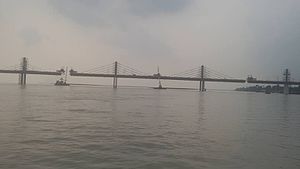Arrah – Chhapra Bridge
Coordinates: 25 ° 43 ′ 40 ″ N , 84 ° 48 ′ 51 ″ E
| Arrah – Chhapra Bridge आरा-छपरा सेतु |
||
|---|---|---|
| Official name | Veer Kunwar Singh Setu वीर कुँवर सिंह सेतु |
|
| Crossing of | Ganges | |
| place | Arrah - Chhapra | |
| construction | Extradosed bridge | |
| overall length | 4000 m | |
| width | 20.5 m | |
| Number of openings | 52 | |
| Longest span | 120 m | |
| start of building | 2010 | |
| completion | 2017 | |
| planner | McElhanney Consulting Services | |
| location | ||
|
|
||
Arrah – Chhapra Bridge ( Bhojpuri : आरा-छपरा सेतु), officially Veer Kunwar Singh Setu (Bhojpuri: वीर कुँवर सिंह सेतु) is a road bridge over the Ganges between the cities of Arrah and Chhapra in the Indian state of Bihar .
In Bihar with 117 million inhabitants and the lowest per capita income in India, there were only three road bridges on a 400 km stretch of the Ganges. The long economic boom in India made the construction of several bridges possible, including the Arrah – Chhapra Bridge.
The bridge was named after Babu Veer Kunwar Singh (1777– April 26, 1858), a Bhojpur- born leader in the Indian uprising of 1857 .
The bridge is considered to be the longest extradosed bridge in the world.
description
The bridge stands in the vast floodplain of the Ganges. Its total length of 4350 m includes 350 m long ramps that merge into the long access road to the NH-30 in the south and that to the NH-19 in the north.
The actual bridge is 4000 m long and consists of the 1920 m long extradosed bridge , the 1790 m long southern and the 290 m northern approach bridge . It is 20.5 m wide and has two lanes and a sidewalk in each direction.
The spans in the southern approach bridge are 50 + 29 × 60 m, in the river bridge 60 + 15 × 120 + 60 m and in the northern approach bridge 4 × 60 + 50 m.
The deck girders of the entire bridge consist of largely the same single-cell prestressed concrete - hollow boxes with a trapezoidal cross-section and a constant height of 3.40 m. A total of 608 segments were prefabricated using the contact method and then lifted into place, glued with epoxy resin and tensioned with tendons.
The main bridge has 16 single-legged, 18 m high pylons arranged in the central axis , which are connected to the girder with 5 parallel stay cables at an angle of 19 °.
The pillars below the deck are 17 m high and each consist of two reinforced concrete slats that can compensate for temperature-related changes in length.
The pillars were founded on round, 9.5 m wide caissons that reach 53 m into the sandy soil.
The bridge was built by the Indian company SP Singla Constructions , which commissioned the Canadian engineering office McElhanney Consulting Services from Vancouver to plan a bridge that was cheaper and faster than the official draft.
The local Veer Kunwar Singh Setu should not be confused with the older bridge of the same name around 80 km upstream near Buxar , which had to be closed for heavy goods traffic.
literature
- Brook R. Robazza, Morgan T. Trowland: Crossing the Ganges: The World's Longest Extradosed Bridge. In: 40th IABSE Symposium, 19–21 September 2018, Nantes, France. Tomorrow's Megastructures, pp. S12-49 to S12-56
Individual evidence
- ↑ Segment installation completed for record-breaking extradosed bridge Article from April 20, 2017 on bridgeweb.com - Bridge Design and Engineering
- ↑ A Veer to the right article from September 7, 2017 on roadsbridges.com
- ↑ Veer Kunwar Singh Setu on mcelhanney.com
- ↑ India's longest multi-span Extradosed Bridge on spsingla.com
- ↑ One way rickety bridges state's lifeline. Article dated June 12, 2016 in The Telegraph, India

